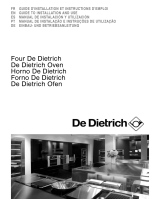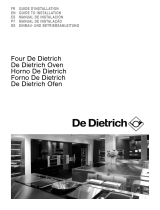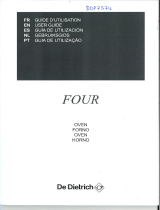Page is loading ...

english
Important:
When you receive the appliance,
unpack it immediately. Give it an
overall inspection. Make note of any
concerns or reservations on the
delivery slip and make sure to keep a
copy of this form. Before starting your
appliance, please read this
installation guide carefully to
familiarise yourself quickly with its
operation. Keep this user guide with
your appliance. If the appliance is
ever sold or transferred to another
person, ensure that the new owner
receives this user guide.
Please become familiar with these
recommendations before installing
and using your oven. They were
written for your safety and the safety
of others.
— Before using your oven for the first
time, heat it while empty for
approximately 15 minutes. Make
sure that the room is sufficiently
ventilated.
— This oven was designed for use by
private persons in their homes. This
oven does not contain any asbestos-
based components.
— Your appliance is intended for
standard household use. Do not use it
for commercial or industrial purposes
or for any other purpose than that for
which it was designed.
— Do not modify or attempt to
modify any of the characteristics of
this appliance. This would be
dangerous to your safety.
— Never place tin foil directly in
contact with the oven floor as the
build up of heat may damage the
enamel.
— Do not place heavy weights on the
open oven door, and make sure that
children are able neither to climb nor
sit on it.
— Do not use your oven as a larder
or to store any items after use.
— After using your oven, make sure
that all the controls are in their stop
position.
— The oven must be turned off when
cleaning inside the oven.
— Before removing the glass
window, allow the appliance to cool
down.
This appliance may be used by
children aged 8 years and
older, and by persons with impaired
physical sensorial or mental
capacities, or without experience or
knowledge, if they are supervised or
have received prior instructions on
how to use the appliance safely and
have understood the risks involved.
IMPORTANT SAFETY INSTRUCTIONS READ CAREFULLY AND
KEEP FOR FUTURE USE.
Safety instructions
This user guide is available for download on the brand’s website.
0

english
Children must not be allowed to play
with the appliance. Cleaning and
maintenance operations must not be
carried out by children without
supervision.
— Children must be supervised to
prevent them from playing with the
appliance.
WARNING: The appliance and its
accessible parts become hot during
use. Be careful not to touch the
heating elements inside the oven.
Children under 8 years old must not
be allowed near it unless they are
supervised at all times.
— This appliance is designed to cook
with the door closed.
— Before pyrolytic cleaning of your
oven, remove all accessories and any
thick deposits.
— During cleaning, the surfaces may
become warmer than under normal
conditions of use. It is advisable to
keep children away from the
appliance.
— Do not use a steam cleaner.
— Before removing the back wall,
the appliance must be powered off.
After cleaning, the back wall must be
put back in place in accordance with
the instructions.
— Do not use abrasive cleaning
products or hard metal scrapers for
cleaning the oven's glass door, as
they could scratch the surface and
cause the glass to shatter.
WARNING: Make sure the
appliance is disconnected from
the power before replacing the lamp
in order to avoid the risk of electric
shock. Change the lamp only when
the appliance has cooled down. To
unscrew the view port and the light,
use a rubber glove, which will make
disassembly easier.
The electrical plug must remain
accessible after installation.
It must be possible to disconnect the
appliance from the power supply,
either using a plug or by fitting a
switch on the fixed wiring system in
accordance with installation rules.
If the power cable is damaged, it
should be replaced by the
manufacturer, its after-sales service
department or by a similarly qualified
person in order to avoid danger.
— This appliance may be installed
either under a worktop or in a cabinet
column, as indicated on the
installation diagram.
— Centre the oven in the unit so as
to ensure a minimum distance of 10
mm between the appliance and the
surrounding unit. The material of the
unit supporting the appliance must be
heat-resistant (or covered with a
heat-resistant material). For greater
stability, attach the oven to the unit
with 2 screws through the holes
provided on the side panels.

english
UNPACKING
Remove all the protection elements. Check and respect
the appliance’s characteristics that appear on the
nameplate (1.1.1)
CHOICE OF LOCATION AND BUILDING IN
The diagrams show the dimensions of a cabinet that will be
able to hold your oven.
This appliance may be installed either under a worktop or in
a cabinet column, as indicated on the installation diagram
(1.2.1 - 1.2.2). If the cabinet is open, its opening must be 70
mm maximum. Your oven has optimised air circulation that
allows it to achieve remarkable cooking and cleaning results
if the following guidelines are followed :
Center the oven in the cabinet to ensure a minimum
distance of 10 mm with adjacent cabinets (1.2.3). The
material or coating of the cabinet must be heat-resistant. For
greater stability, attach the oven in the cabinet with two
screws through the holes provided for this purpose on either
side of the front inner panel.
- Drill a 2 mm diameter hole in the cabinet panel to avoid
splitting the wood.
- Attach the oven with the two screws (1.2.4) .
Tip:
To be certain that you have properly installed
your appliance, do not hesitate to call on a household
appliance specialist.
ELECTRIC CONNECTION
The appliance must be recess-fitted correctly to ensure
electrical safety.
The electrical connections are made before the appliance is
installed in its housing.
Ensure that:
- the electrical installation has sufficient voltage,
- the electrical wires are in good condition,
- the diameter of the wires complies with the installation
requirements.
During maintenance operations, the appliance must be
unplugged from the electrical grid; fuses must be switched
off or removed.
Warning:
The safety wire (green-yellow) is connected to the
appliance’s terminal and must be connected to the
earth terminal of the electrical set-up.
The fuse in your set-up must be 16 amperes.
If the electrical installation in your residence requires
any changes in order to hook up your appliance, call
upon a professional electrician. If the oven malfunctions
in any way, unplug the appliance or remove the fuse
corresponding to the sector where the oven is hooked
up.
This oven has 3 positions for the accessories:
supports from 1 to 3 (2.1.1).
ACCESSORIES (depending on the model)
• Anti-rocking safety grid (2.2.1)
The grid can be used to hold all dishes and moulds
containing foodstuffs to be cooked or browned. It can be
used for barbecues (to be placed directly on the grid).
• Baking sheet (2.2.2)
This aluminium baking sheet features a food-grade non-
stick surface and is designed especially for your pastry
creations, particularly light pastries.
1.1
1.2
1.3
Installation
Accessories
2.1
2.2
1
2

english
You can set your choux and puff pastries, meringues,
madeleines and other delights directly on it.
N.B.: The baking sheet should never be used to hold baking
dishes or cake moulds.
• Multi-purpose 20 mm dish (2.2.3)
• Multi-purpose 45 mm dish (2.2.4)
When inserted in the supports under the grid, it collects juice
and fat from grilling, and can be used half-filled with water
as a double-boiler.
• 45 mm multi-purpose tray. Fully accessible sliding rail
system (2.2.5)
The new sliding rail system with support (fully accessible)
makes food more practical and easier to handle as the trays
can be effortlessly pulled for simpler handling. The trays can
be completely removed, providing full access (2.2.6).
Their stability ensures that food can be handled safely,
reducing the risk of burns. This means that you can take
food out of the oven far more easily (2.2.7).
The drip tray in the bottom of the oven collects juice and fat
from grilling, and can be used half-filled with water as a
double-boiler. Do not directly place meat or poultry on the
drip tray for roasting. This would inevitably produce splashes
and dirty the sides of the oven.
• 45 mm deep dish with a support grid for grilling (2.2.8)
This is used to collect cooking juices from meat or fish
placed directly on its grill in grill or pulsed grill sequence.
Never place this dish on the oven floor (risk of damage to the
enamel) except in grill position (the oven floor heating
element does not operate in these positions).
Warning:
Before starting a pyrolysis cleaning cycle, make sure
that any accessories that are not pyrolysis safe have
been removed from the oven (sliding rails, baking trays,
chrome-plated grills, and so on) as well as any
cookware. The side grills are pyrolysis safe and may be
left inside the oven during pyrolysis.
CLEANING THE OUTER SURFACES
To clean both the electronic programmer window and the
oven door, use a window washing product applied to a soft
cloth. Do not use abrasive creams or scouring sponges.
CLEANING THE INNER SURFACES
NO PYROLYSIS OVENS
• Smooth side panel models (3.1.1).
- Clean the still-warm oven with a cloth dipped in hot, soapy
water.
REMOVING THE WIRE SHELF SUPPORTS
Warning
For any cleaning operation inside the oven cavity, the
oven must be switched off.
Before starting to disassemble the appliance, allow it to
cool down and ensure that it has been disconnected
from the power supply.
Wire shelf supports with hooks.
To remove them, lift up the front part of the shelf support to
disengage the front hook from its housing (3.2.1).
3.1
3.2
Cleaning
3

english
Then gently pull the whole of the support towards you and
lift the back to release the rear hook from its housing (3.2.2).
Pull out the two shelf side supports.
PYROLYSIS OVENS
WHAT IS PYROLYSIS?
Warning
Remove any cookware, grids and trays from the oven
and clean any major spill residue before carrying out the
pyrolysis.
Tip
Your oven is equipped with enamelled wire shelf
supports: these need to be removed before running
the pyrolysis cycle.
- Pyrolysis is a cycle during which the oven cavity is heated
to a very high temperature in order to eliminate soiling from
splattering and spills. The smoke and odours released are
destroyed as they move through a catalyser.
- Pyrolysis is not necessary after each cooking cycle, simply
when the degree of soiling warrants it.
- As a safety measure, cleaning only occurs after the door
locks automatically. As soon as the internal temperature of
the oven exceeds cooking temperatures, it is impossible to
unlock the door even if the “function selector” is set to 0.
WHEN TO USE PYROLYSIS
If your oven emits smoke during preheating or releases large
amounts of smoke during cooking. If your oven releases an
unpleasant odour when cooled after various cooking
applications (lamb, fish, barbecue, etc...).
Relatively clean cooking operations:
Biscuits, vegetables, pastry, quiches, soufflés
Splatter-free cooking
->pyrolysis is not warranted.
Messy cooking operations:
Meats, fish (in a dish), stuffed vegetables.
->Pyrolysis may be warranted after three cooking cycles.
Very messy cooking operations:
Large cuts of meat on the spit.
-> Pyrolysis can be performed after one cooking application
of this kind, as there is a lot of splattering.
Tip
You should not wait until the oven is overly coated in
grease to initiate a cleaning cycle.
CLEANING THE DOOR
• Removing the door (depending on the model)
Warning
— Do not use abrasive cleaning products or hard metal
scrapers for cleaning the oven’s glass door, which could
scuff the surface and cause the glass to shatter.
— Before removing the glass window, allow the
appliance to cool down.
- Open the door completely and block it open using the two
red stops (3.3.1).
They are supplied with your machine in the plastic pack.
- To remove the frame and glass assembly, proceed as
follows:
Insert the two red stops in the A slots designed for this
(3.3.2).
- Lever the assembly to detach the frame and the glass
(3.3.3).
- Remove the frame and the glass (3.3.4).
- Remove all the door’s interior windows by rotating them.
This assembly comprises 2 glass windows, the 1st of which
has 2 rubber stops on the 2 front corners.(3.3.5).
- Clean the glass using a soft sponge and washing-up liquid.
Do not soak the window in water.
Do not use abrasive creams or scouring sponges. Rinse with
clean water and dry off with a lint-free wiper.
- After cleaning, replace the 1st glass in the door.
Reposition the 2 black rubber stops on the front corners of
the 2nd glass, taking care to follow the indications on the
3.3

english
glass:
top left: L
top right: R
Then replace the door and the 2nd glass, positioning it on
the first (3.3.6).
Place the glass frame assembly back in the door (3.3.7).
- Take care to correctly slot the frame under the spigot next
to the hinge (3.3.8).
- Attach the frame by tightening it with the door.
Do not press on the frame alone. (3.3.9).
Your appliance can now be used again.
REPLACING THE OVEN LAMP
WARNING:
Make sure the appliance is disconnected from the
power before replacing the lamp in order to avoid the
risk of electric shock. Change the lamp only when the
appliance has cooled down.
Remove the wire shelf supports.
- The lamps are accessible inside the oven (3.4.1).
- Use the red stop as a lever to remove the glass (3.4.2).
- Remove the bulb (3.4.3).
Bulb specification:
- 25W,
- 220-240 V~,
- 300°C
- G9.
- Replace the bulb, then replace the glass and reconnect
the oven.
CARE FOR THE ENVIRONMENT
- This appliance’s packing materials are recyclable. Please
recycle them and help protect the environment by depositing
them in municipal containers provided for this purpose.
- Your appliance also contains many
recyclable materials. It is therefore marked
with this logo to indicate that used appliances
must not be mixed with other waste.
The appliance recycling organised by your
manufacturer will therefore be conducted in optimum
conditions, in accordance with European directive
2002/96/EC on electrical and electronic equipment waste.
Consult your local authority or your retailer to locate your
nearest used appliance drop-off points.
- We thank you for your help in protecting the environment.
STAND-BY MODE.
In order to limit power consumption, the display will fade
after 30 seconds of inactivity. Depending on the model of
oven, when a delayed start is programmed, an animation
will display alternately with the time, indicating that the oven
is in “standby mode”. The display will return to normal
brightness if the cooking selector is activated or if a button
is pressed.
Environment
4.1
4
3.4
GENUINE REPLACEMENT PARTS
During maintenance work, request that only
certified
genuine replacement parts are used.
/





